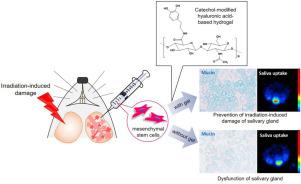当前位置:
X-MOL 学术
›
J. Ind. Eng. Chem.
›
论文详情
Our official English website, www.x-mol.net, welcomes your feedback! (Note: you will need to create a separate account there.)
Prevention of irradiation-induced damage to salivary glands by local delivery of adipose-derived stem cells via hyaluronic acid-based hydrogels
Journal of Industrial and Engineering Chemistry ( IF 6.1 ) Pub Date : 2020-10-01 , DOI: 10.1016/j.jiec.2020.06.014 Eun-Jae Chung , Ji Suk Choi , Jisoo Shin , Ha-Na Cho , Suyeon Kim , Ji Yong Park , Yun-sang Lee , Yong-il Kim , Hong-Gyun Wu , Seung-Woo Cho , Seong Keun Kwon
Journal of Industrial and Engineering Chemistry ( IF 6.1 ) Pub Date : 2020-10-01 , DOI: 10.1016/j.jiec.2020.06.014 Eun-Jae Chung , Ji Suk Choi , Jisoo Shin , Ha-Na Cho , Suyeon Kim , Ji Yong Park , Yun-sang Lee , Yong-il Kim , Hong-Gyun Wu , Seung-Woo Cho , Seong Keun Kwon

|
Abstract Most patients with head and neck cancer experience salivary gland dysfunction after chemo- and radiotherapies. There is currently no available treatment for this condition. Intervention with stem cell therapy has emerged as a promising approach. Although some progress has been made with systemic delivery of stem cells, it remains challenging to deliver a sufficient number of stem cells to the damaged tissue. Furthermore, local delivery of stem cells involves frequent cell loss. Herein, we evaluated the ability of adipose-derived stem cells (ASCs) with or without hydrogel to prevent salivary gland damage. Salivary gland cells were isolated from irradiated mouse submandibular glands. These cells exhibited higher expression levels of amylase, mucin, and aquaporin-5 when co-cultured with ASCs. Local delivery of ASCs into the salivary gland, using in situ-forming hyaluronic acid-based hydrogel (HA gel) as a carrier, revealed that ASCs remained at the injection site for a longer duration, compared with ASCs that were injected without HA gel. The salivary gland exhibited better function and morphology when ASCs were injected using an HA gel. In conclusion, retention of locally delivered ASCs by HA gels can enhance the paracrine effect of ASCs, thereby preventing irradiation-induced damage to the salivary gland and subsequent dysfunction.
中文翻译:

通过基于透明质酸的水凝胶局部递送脂肪干细胞来预防辐射诱导的唾液腺损伤
摘要 大多数头颈癌患者在化疗和放疗后都会出现唾液腺功能障碍。目前没有针对这种情况的可用治疗方法。干细胞疗法的干预已成为一种有前途的方法。尽管在系统性递送干细胞方面取得了一些进展,但向受损组织递送足够数量的干细胞仍然具有挑战性。此外,干细胞的局部递送涉及频繁的细胞丢失。在此,我们评估了有或没有水凝胶的脂肪干细胞 (ASC) 防止唾液腺损伤的能力。从辐照的小鼠下颌下腺中分离唾液腺细胞。当与 ASC 共培养时,这些细胞表现出更高的淀粉酶、粘蛋白和水通道蛋白 5 表达水平。ASCs 局部输送到唾液腺,使用原位形成的透明质酸基水凝胶(HA 凝胶)作为载体,表明与未注射 HA 凝胶的 ASCs 相比,ASCs 在注射部位停留的时间更长。当使用 HA 凝胶注射 ASCs 时, 唾液腺表现出更好的功能和形态。总之,HA 凝胶保留局部递送的 ASCs 可以增强 ASCs 的旁分泌作用,从而防止辐射引起的唾液腺损伤和随后的功能障碍。
更新日期:2020-10-01
中文翻译:

通过基于透明质酸的水凝胶局部递送脂肪干细胞来预防辐射诱导的唾液腺损伤
摘要 大多数头颈癌患者在化疗和放疗后都会出现唾液腺功能障碍。目前没有针对这种情况的可用治疗方法。干细胞疗法的干预已成为一种有前途的方法。尽管在系统性递送干细胞方面取得了一些进展,但向受损组织递送足够数量的干细胞仍然具有挑战性。此外,干细胞的局部递送涉及频繁的细胞丢失。在此,我们评估了有或没有水凝胶的脂肪干细胞 (ASC) 防止唾液腺损伤的能力。从辐照的小鼠下颌下腺中分离唾液腺细胞。当与 ASC 共培养时,这些细胞表现出更高的淀粉酶、粘蛋白和水通道蛋白 5 表达水平。ASCs 局部输送到唾液腺,使用原位形成的透明质酸基水凝胶(HA 凝胶)作为载体,表明与未注射 HA 凝胶的 ASCs 相比,ASCs 在注射部位停留的时间更长。当使用 HA 凝胶注射 ASCs 时, 唾液腺表现出更好的功能和形态。总之,HA 凝胶保留局部递送的 ASCs 可以增强 ASCs 的旁分泌作用,从而防止辐射引起的唾液腺损伤和随后的功能障碍。


























 京公网安备 11010802027423号
京公网安备 11010802027423号